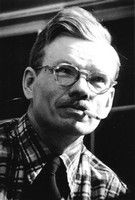Kenneth Stubbs |
 |
Kenneth Stubbs |
 |
|
Throng of Friendly Visitors Sees Washington Artists' Guild ExhibitA large and friendly throng of visitors more concerned than usual on these occasions with looking about the room as well as at each other, turned out for the opening of the second annual exhibit of the Artists' Guild of Washington at Corcoran last Sunday. What they saw was a display ranging from the solidly conservative to the experimental, a varied assemblage that contains work of real distinction, has plenty of verve to carry it over the weak spots, and that marks a positive gain over last year. This gain is more significant than it would be in normal times. Without bothering to mention the fact that a good part of the vital creative talent in this country is now channeled in other directions, there is a certain type of aesthetic defeatist who has taken the moment to proclaim (as one did in a recent magazine article) that "American art, like American literature, seems to be in retreat." Since the airing of this view is prevalent and goes with a tendency to burrow underground for the duration, it is a pleasure to report any evidence to the contrary. Gallery Is Full The show at the Corcoran, which consists of close to 100 entries in all, is composed of paintings, sculptures, prints, and drawings. The gallery is full to capacity and in some places the hanging had to be doubled. Several sales have already resulted, including works by Paul Arlt, William Calfee, Sarah Baker, and Edward Rosenfeld, the last named exhibiting with this group for the first time. Since portraits, except for the slick variety, are in the minority these days, it is worth noting that there are several completely unaffected and able paintings in this category. Carl Nyquist's portrait of an Irishman is the best work by him that we have ever seen, and we liked the forthright yet sensitive character of the two contributions by Sybil Bonbright. One of the surprises in the show is a spirited oil by the printmaker and water colorist, Prentiss Taylor, the first, he says, in about 18 years. The only war subjects offered are by two members, Olin Dows and Mitchell Jamieson, who have been on active service with the Army and Navy respectively. Examples of commissioned work by these two, who are well known to Washington, were lent to the exhibit by the Government. Work Characteristic In addition there are several nonmilitary paintings and sketches by members of the Guild who are now serving with some branch of the service. These include a vertical figure painting by Jack Berkman, landscapes by Sheffield Kagy and Robert Gates, and drawings by Kenneth Stubbs. The majority of the exhibitors have shown here frequently, and most of them are represented by characteristic work, some to better advantage than others. The Corcoran teachers, Richard Lahey and Eugen Weisz, for example, are both represented. Andrea Pietro Zerega has a typical landscape and a more ambitious, not too successful, figure study, and Walter T. Carnelli, an arresting self-portrait and a landscape previously shown here. Harold Giese has one particulary successful small oil, and there is an excellent pair by Oke Nordgren. Several of the women painters have contributed still lifes. Besides these, there are characeteristic paintings by John Gernand, Marguerite Burgess, Mary Bradley, Majorie Phillips, Douglas Brown, Jacob Kainen, Alice Acheson and William Thompson. Julia Eckel has the only abstraction, Lois Jones a soundly constructed figure composition, and Richard Kenah a street scene. Small oils are noted by two new exhibitors, Frances Ferry and Frances foote, and there is an unusual contribution by the young Cuban painter, Marageret de Mena, also a new member. Pietro Lazzari's new composition attracted considerable attention, but we still prefer his drawings. Jane Watson, Washington Post, January 9, 1944, page 10-S
|